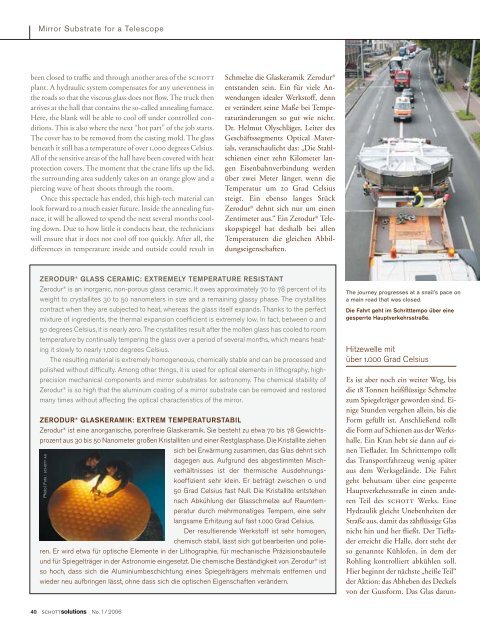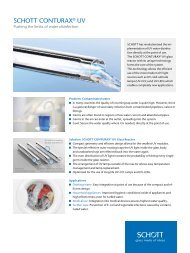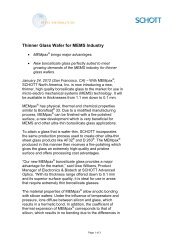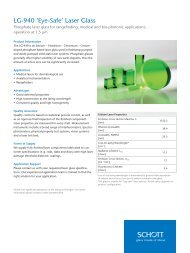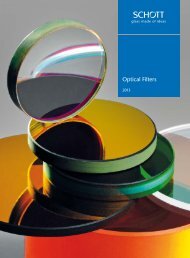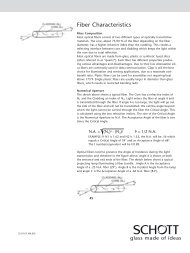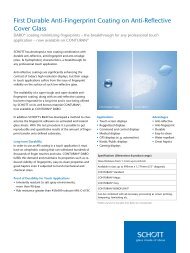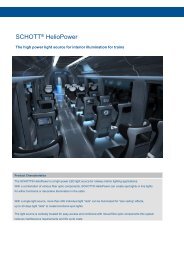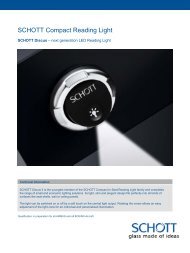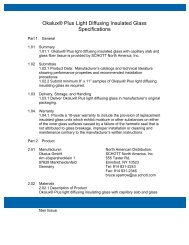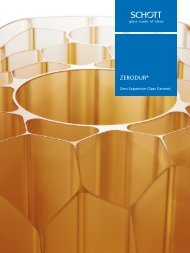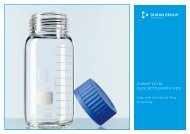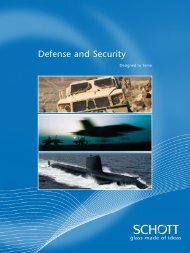Create successful ePaper yourself
Turn your PDF publications into a flip-book with our unique Google optimized e-Paper software.
Mirror Substrate for a Telescope<br />
been closed to traffic and through another area of the schott<br />
plant. A hydraulic system compensates for any unevenness in<br />
the roads so that the viscous glass does not flow. The truck then<br />
arrives at the hall that contains the so-called annealing furnace.<br />
Here, the blank will be able to cool off under controlled conditions.<br />
This is also where the next “hot part” of the job starts.<br />
The cover has to be removed from the casting mold. The glass<br />
beneath it still has a temperature of over 1,000 degrees Celsius.<br />
All of the sensitive areas of the hall have been covered with heat<br />
protection covers. The moment that the crane lifts up the lid,<br />
the surrounding area suddenly takes on an orange glow and a<br />
piercing wave of heat shoots through the room.<br />
Once this spectacle has ended, this high-tech material can<br />
look forward to a much easier future. Inside the annealing furnace,<br />
it will be allowed to spend the next several months cooling<br />
down. Due to how little it conducts heat, the technicians<br />
will ensure that it does not cool off too quickly. After all, the<br />
differences in temperature inside and outside could result in<br />
ZERODUR ® GLASS CERAMIC: EXTREMELY TEMPERATURE RESISTANT<br />
Zerodur ® is an inorganic, non-porous glass ceramic. It owes approximately 70 to 78 percent of its<br />
weight to crystallites 30 to 50 nanometers in size and a remaining glassy phase. The crystallites<br />
contract when they are subjected to heat, whereas the glass itself expands. Thanks to the perfect<br />
mixture of ingredients, the thermal expansion coefficient is extremely low. In fact, between 0 and<br />
50 degrees Celsius, it is nearly zero. The crystallites result after the molten glass has cooled to room<br />
temperature by continually tempering the glass over a period of several months, which means heating<br />
it slowly to nearly 1,000 degrees Celsius.<br />
The resulting material is extremely homogeneous, chemically stable and can be processed and<br />
polished without difficulty. Among other things, it is used for optical elements in lithography, highprecision<br />
mechanical components and mirror substrates for astronomy. The chemical stability of<br />
Zerodur ® is so high that the aluminum coating of a mirror substrate can be removed and restored<br />
many times without affecting the optical characteristics of the mirror.<br />
ZERODUR ® GLASKERAMIK: EXTREM TEMPERATURSTABIL<br />
Zerodur ® ist eine anorganische, porenfreie Glaskeramik. Sie besteht zu etwa 70 bis 78 Gewichtsprozent<br />
aus 30 bis 50 Nanometer großen Kristalliten und einer Restglasphase. Die Kristallite ziehen<br />
sich bei Erwärmung zusammen, das Glas dehnt sich<br />
dagegen aus. Aufgrund des abgestimmten Mischverhältnisses<br />
ist der thermische Ausdehnungskoeffizient<br />
sehr klein. Er beträgt zwischen 0 und<br />
50 Grad Celsius fast Null. Die Kristallite entstehen<br />
nach Abkühlung der Glasschmelze auf Raumtemperatur<br />
durch mehrmonatiges Tempern, eine sehr<br />
langsame Erhitzung auf fast 1.000 Grad Celsius.<br />
Der resultierende Werkstoff ist sehr homogen,<br />
chemisch stabil, lässt sich gut bearbeiten und polieren.<br />
Er wird etwa für optische Elemente in der Lithographie, für mechanische Präzisionsbauteile<br />
und für Spiegelträger in der Astronomie eingesetzt. Die chemische Beständigkeit von Zerodur ® ist<br />
so hoch, dass sich die Aluminiumbeschichtung eines Spiegelträgers mehrmals entfernen und<br />
wieder neu aufbringen lässt, ohne dass sich die optischen Eigenschaften verändern.<br />
Photo | Foto : schott ag<br />
40 schottsolutions No. 1/ 2006<br />
Schmelze die Glaskeramik Zerodur ®<br />
entstanden sein. Ein für viele Anwendungen<br />
idealer Werkstoff, denn<br />
er verändert seine Maße bei Temperaturänderungen<br />
so gut wie nicht.<br />
Dr. Helmut Olyschläger, Leiter des<br />
Geschäftssegments Optical Materials,<br />
veranschaulicht das: „Die Stahlschienen<br />
einer zehn Kilometer langen<br />
Eisenbahnverbindung werden<br />
über zwei Meter länger, wenn die<br />
Temperatur um 20 Grad Celsius<br />
steigt. Ein ebenso langes Stück<br />
Zerodur ® dehnt sich nur um einen<br />
Zentimeter aus.“ Ein Zerodur ® Teleskopspiegel<br />
hat deshalb bei allen<br />
Temperaturen die gleichen Abbildungseigenschaften.<br />
The journey progresses at a snail’s pace on<br />
a main road that was closed.<br />
Die Fahrt geht im Schritttempo über eine<br />
gesperrte Hauptverkehrsstraße.<br />
Hitzewelle mit<br />
über 1.000 Grad Celsius<br />
Es ist aber noch ein weiter Weg, bis<br />
die 18 Tonnen heißflüssige Schmelze<br />
zum Spiegelträger geworden sind. Einige<br />
Stunden vergehen allein, bis die<br />
Form gefüllt ist. Anschließend rollt<br />
die Form auf Schienen aus der Werkshalle.<br />
Ein Kran hebt sie dann auf einen<br />
Tieflader. Im Schritttempo rollt<br />
das Transportfahrzeug wenig später<br />
aus dem Werksgelände. Die Fahrt<br />
geht behutsam über eine gesperrte<br />
Hauptverkehrsstraße in einen anderen<br />
Teil des schott Werks. Eine<br />
Hydraulik gleicht Unebenheiten der<br />
Straße aus, damit das zähflüssige Glas<br />
nicht hin und her fließt. Der Tieflader<br />
erreicht die Halle, dort steht der<br />
so genannte Kühlofen, in dem der<br />
Rohling kontrolliert abkühlen soll.<br />
Hier beginnt der nächste „heiße Teil“<br />
der Aktion: das Abheben des Deckels<br />
von der Gussform. Das Glas darun-


